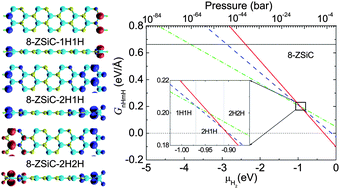Based on density functional theory and nonequilibrium Green's function method, we systematically investigated the hydrogenated effects on the stability, electronic and magnetic properties, as well as electronic spin transport property of an N chains zigzag silicon carbide nanoribbon (N-ZSiC NR). Our calculated results indicate that by controlling the hydrogen content of the environment, one can get three types of stable edge hydrogenated ZSiC NRs. They are: (a) each edge Si and C atom bonded with one hydrogen atom (N-ZSiC-1H1H), (b) each edge Si atom bonded with two H atoms and each edge C bonded with one H atom (N-ZSiC-2H1H), and (c) each edge Si and C atom bonded with two H atoms (N-ZSiC-2H2H). It was unexpectedly found that N-ZSiC-1H1H NR, which has been studied theoretically to a large extent, is stable only at extremely low ultravacuum pressures. Under more standard conditions, the most stable edge hydrogenated structure is N-SiC-2H2H NR. More interestingly, when N ≤ 4, the N-ZSiC-2H2H NR is a nonmagnetic semiconductor, while when 5 ≤ N ≤ 7, it is a ferrimagnetic ferromagnetic semiconductor. When N ≥ 8, the N-SiC-2H2H NR turns into a ferrimagnetic half-metallic. As regards the N-ZSiC-2H1H NR, when N ≤ 12, it is a ferromagnetic semiconductor, while when N ≥ 13, it becomes a ferromagnetic half-metallic. These results manifest that by controlling the hydrogen content of the environment and the temperature, as well as the ribbon width N, one can precisely modulate the electronic and magnetic properties of N-ZSiC NRs, which endows ZSiC NRs with many potential applications in spintronics and nanodevices.


 Please wait while we load your content...
Please wait while we load your content...